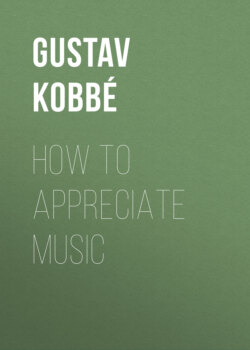Читать книгу How to Appreciate Music - Gustav Kobbé - Страница 5
На сайте Литреса книга снята с продажи.
Music Under One’s Fingers.
ОглавлениеBut this is not all. There is an overture by Weber entitled “The Ruler of the Spirits.” Well, he who commands the row of white and black keys is ruler of the spirits of music. He has music, all that music can give, within the grasp of his two hands, under his ten fingers. The pianoforte can render anything in music. Besides music of its own, it can reproduce the orchestra or the voice with even greater fidelity than the finest engraving renders a painting; for only to the eyes 32 of one familiar with the painting does the engraving suggest the color scheme of the original, whereas, through certain nuances of technique that are more easily felt than described, the pianoforte virtuoso who is playing an arrangement of an orchestra composition can make his audience hear certain instruments of the orchestra—even such characteristic effects as the far-carrying pizzicato, or the rumbling of the double basses or their low growl; the hollow, reverberating percussions of the tympani; sustained notes on the horns; the majestic accents of trombones; the sharp shrill of piccolos; while some of the most effective pianoforte pieces are arrangements of songs.
Moreover, there are pianoforte compositions like the Hungarian rhapsodies of Liszt which, while conceived and carried out in the true spirit of the instrument (“pianistic,” as they say), yet suggest the tone colors of the orchestra without permitting these to obtrude themselves too much. This is one of the many services of Liszt, the giant of virtuosos and a giant among composers, to his art. It has been said that Liszt played the whole orchestra on the pianoforte. He did even more. He developed the technique of the instrument to such a point that the suggestion of many of the clang tints of the orchestra has become part of its heritage. This dual capacity of the pianoforte, the fact that it has a tone quality wholly peculiar to itself, so that when, for example, we are playing Chopin we never think of the orchestra, while at the same time it can take up into itself and reproduce, or at least suggest, the tone colors of other instruments, is one of its most remarkable characteristics.
33
Quite as remarkable and as interesting and important is the circumstance that these tone tints are wholly dependent upon the player. There is nothing peculiar to the make of the strings, the sounding-board, the hammers, that tends to produce these effects. They are due wholly to the player’s subtle manipulation of the keys, so that we get the added thrill of the virtuoso’s personal magnetism. The pianoforte owes much of its popularity, much of its supremacy, to the fact that a player’s interpretation of a composition cannot be marred by any one but himself. It rests in his hands alone, whereas the conductor of an orchestra is dependent upon a hundred players, some of whom may have no more soul than so many wooden Indians. Even supposing a conductor to be gifted with a highly poetic and musically sensitive nature, it is impossible that so many men of varying degrees of temperament as go to make up an orchestra, and none of them probably a virtuoso of the highest rank, will be as sympathetically responsive to his baton as a pianoforte is to the fingers of a musical poet like Paderewski; for the fingers of a great virtuoso are the ambassadors of his soul.
